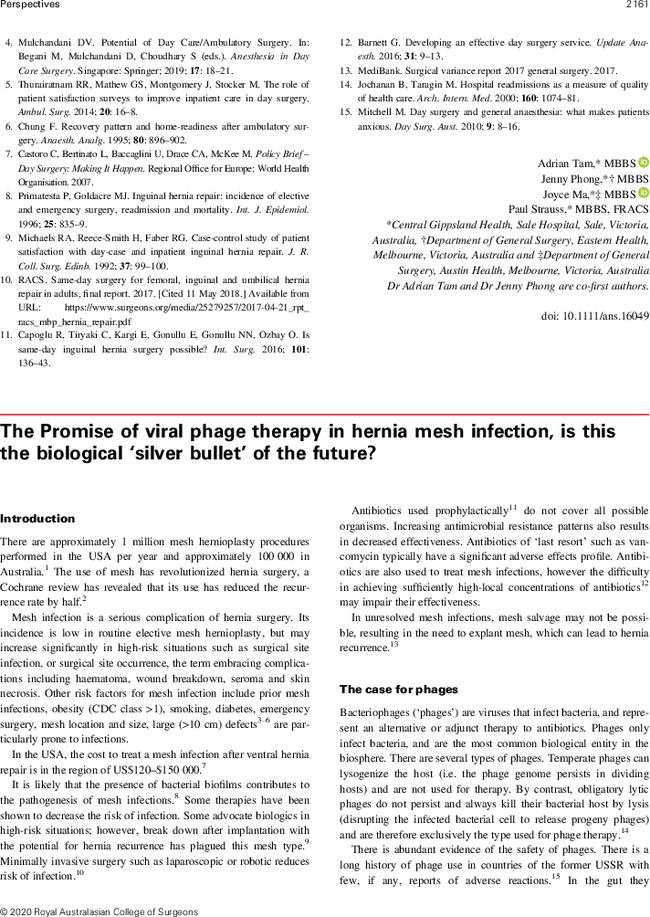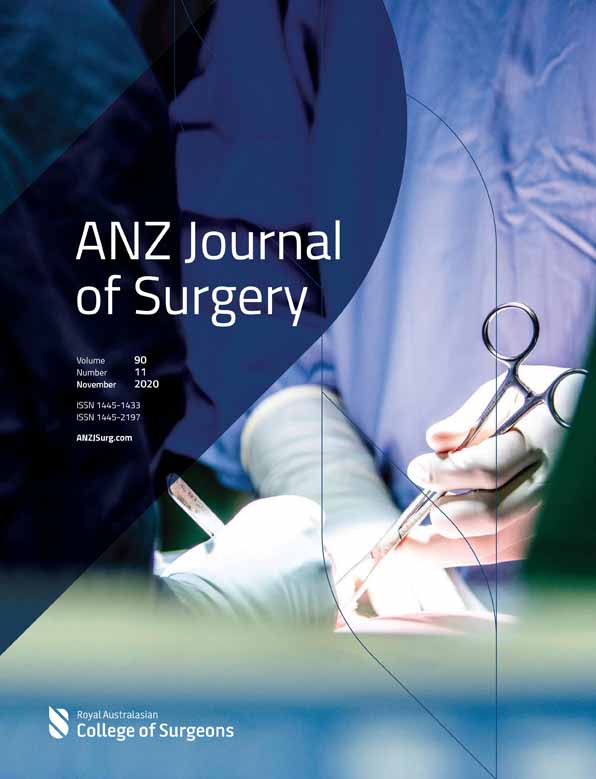The Promise of viral phage therapy in hernia mesh infection, is this the biological ‘silver bullet’ of the future?
Peter Speck BSc (Hons), PhD, FASM
College of Science and Engineering, Flinders University, Adelaide, South Australia, Australia
Search for more papers by this authorMorgyn Warner MD, PhD
Infectious Diseases Unit, The Queen Elizabeth Hospital, Adelaide, South Australia, Australia
Search for more papers by this authorJason Clark BSc, PhD
Microbiology and Infectious Diseases Directorate, SA Pathology, Adelaide, South Australia, Australia
Faculty of Health and Medical Sciences, University of Adelaide, Adelaide, South Australia, Australia
Fixed Phage Ltd, Glasgow, UK
Search for more papers by this authorAnita Jacombs BSc (Hons), Grad DipMBBS, PhD, FRACS
Faculty of Medicine and Health Sciences, Macquarie University, Sydney, New South Wales, Australia
Search for more papers by this authorAlex Karatassas MBBS, FRACS, MS
The Queen Elizabeth Hospital, Department of Surgery, University of Adelaide, Adelaide, South Australia, Australia
Search for more papers by this authorChris Hensman MBBS, FRACS, MS
Department of Surgery, Monash University, Melbourne, Victoria, Australia
Search for more papers by this authorPeter Speck BSc (Hons), PhD, FASM
College of Science and Engineering, Flinders University, Adelaide, South Australia, Australia
Search for more papers by this authorMorgyn Warner MD, PhD
Infectious Diseases Unit, The Queen Elizabeth Hospital, Adelaide, South Australia, Australia
Search for more papers by this authorJason Clark BSc, PhD
Microbiology and Infectious Diseases Directorate, SA Pathology, Adelaide, South Australia, Australia
Faculty of Health and Medical Sciences, University of Adelaide, Adelaide, South Australia, Australia
Fixed Phage Ltd, Glasgow, UK
Search for more papers by this authorAnita Jacombs BSc (Hons), Grad DipMBBS, PhD, FRACS
Faculty of Medicine and Health Sciences, Macquarie University, Sydney, New South Wales, Australia
Search for more papers by this authorAlex Karatassas MBBS, FRACS, MS
The Queen Elizabeth Hospital, Department of Surgery, University of Adelaide, Adelaide, South Australia, Australia
Search for more papers by this authorChris Hensman MBBS, FRACS, MS
Department of Surgery, Monash University, Melbourne, Victoria, Australia
Search for more papers by this author
References
- 1Rutkow IM. Demographic and socioeconomic aspects of hernia repair in the United States in 2003. Surg. Clin. North Am. 2003; 83: 1045–51.
- 2Lockhart K, Dunn D, Teo S et al. Mesh versus non-mesh for inguinal and femoral hernia repair. Cochrane Database Syst. Rev. 2018; 9: CD011517.
- 3Sosin M, Nahabedian MY, Bhanot P. The perfect plane: a systematic review of mesh location and outcomes, update 2018. Plast. Reconstr. Surg. 2018; 142: 107S–16S.
- 4Finan KR, Vick CC, Kiefe CI, Neumayer L, Hawn MT. Predictors of wound infection in ventral hernia repair. Am. J. Surg. 2005; 190: 676–81.
- 5Kanters AE, Krpata DM, Blatnik JA, Novitsky YM, Rosen MJ. Modified hernia grading scale to stratify surgical site occurrence after open ventral hernia repairs. J. Am. Coll. Surg. 2012; 215: 787–93.
- 6Berger RL, Li LT, Hicks SC, Davila JA, Kao LS, Liang MK. Development and validation of a risk-stratification score for surgical site occurrence and surgical site infection after open ventral hernia repair. J. Am. Coll. Surg. 2013; 217: 974–82.
- 7Margaret A, Plymale DLD, Walsh-Blackmore S et al. Costs and complications associated with infected mesh for ventral hernia repair. Surg. Infect. 2019; 21: 344–9.
- 8Jacombs ASW, Karatassas A, Klosterhalfen B, Richter K, Patiniott P, Hensman C. Biofilms and effective porosity of hernia mesh: are they silent assassins? Hernia 2020; 24: 197–204.
- 9Costa A, Adamo S, Gossetti F et al. Biological scaffolds for abdominal wall repair: future in clinical application? Materials 2019; 12: 15.
- 10Pokala B, Armijo PR, Flores L, Hennings D, Oleynikov D. Minimally invasive inguinal hernia repair is superior to open: a national database review. Hernia 2019; 23: 593–9.
- 11Sanchez-Manuel FJ, Lozano-García J, Seco-Gil JL. Antibiotic prophylaxis for hernia repair. Cochrane Database Syst. Rev. 2012; 2: CD003769.
- 12Bergeron MG. Tissue penetration of antibiotics. Clin. Biochem. 1986; 19: 90–100.
- 13Hanna M, Dissanaike S. Mesh ingrowth with concomitant bacterial infection resulting in inability to explant: a failure of mesh salvage. Hernia 2015; 19: 339–44.
- 14Abedon ST, Kuhl SJ, Blasdel BG, Kutter EM. Phage treatment of human infections. Bacteriophage 2011; 1: 66–85.
- 15Sulakvelidze A, Alavidze Z, Morris JG Jr. Bacteriophage therapy. Antimicrob. Agents Chemother. 2001; 45: 649–59.
- 16Reyes A, Semenkovich NP, Whiteson K, Rohwer F, Gordon JI. Going viral: next-generation sequencing applied to phage populations in the human gut. Nat. Rev. Microbiol. 2012; 10: 607–17.
- 17Suttle CA. Marine viruses-major players in the global ecosystem. Nat. Rev. Microbiol. 2007; 5: 801–12.
- 18Mutti M, Corsini L. Robust approaches for the production of active ingredient and drug product for human phage therapy. Front. Microbiol. 2019; 10. https://doi.org/10.3389/fmicb.2019.02289.
- 19Drilling A, Morales S, Jardeleza C, Vreugde S, Speck P, Wormald PJ. Bacteriophage reduces biofilm of Staphylococcus aureus ex vivo isolates from chronic rhinosinusitis patients. Am. J. Rhinol. Allergy 2014; 28: 3–11.
- 20Fong SA, Drilling A, Morales S et al. Activity of bacteriophages in removing biofilms of Pseudomonas aeruginosa isolates from chronic Rhinosinusitis patients. Front. Cell. Infect. Microbiol. 2017; 7: 418.
- 21Geredew Kifelew L, Mitchell JG, Speck P. Mini-review: efficacy of lytic bacteriophages on multispecies biofilms. Biofouling 2019; 35: 1–10.
- 22Falagas ME, Kasiakou SK. Mesh-related infections after hernia repair surgery. Clin. Microbiol. Infect. 2005; 11: 3–8.
- 23Lehman SM, Mearns G, Rankin D et al. Design and preclinical development of a phage product for the treatment of antibiotic-resistant Staphylococcus aureus infections. Viruses 2019; 11: 88.
- 24Pirnay JP, Verbeken G, Ceyssens PJ et al. The magistral phage. Viruses 2018; 10: 64.
- 25Djebara S, Maussen C, De Vos D et al. Processing phage therapy requests in a Brussels military hospital: lessons identified. Viruses 2019; 11: 265.
10.3390/v11030265 Google Scholar
- 26Pirnay JP, De Vos D, Verbeken G. Clinical application of bacteriophages in Europe. Microbiol. Aust. 2019; 40: 8–15.
- 27Chan BK, Abedon ST, Loc-Carrillo C. Phage cocktails and the future of phage therapy. Future Microbiol. 2013; 8: 769–83.
- 28Anany H, Chen W, Pelton R, Griffiths MW. Biocontrol of listeria monocytogenes and Escherichia coli O157:H7 in meat by using phages immobilized on modified cellulose membranes. Appl. Environ. Microbiol. 2011; 77: 6379–87.
- 29Arya SK, Singh A, Naidoo R, Wu P, McDermott MT, Evoy S. Chemically immobilized T4-bacteriophage for specific Escherichia coli detection using surface plasmon resonance. Analyst 2011; 136: 486–92.
- 30Gervals L, Gel M, Allain B et al. Immobilization of biotinylated bacteriophages on biosensor surfaces. Sens. Actuator B Chem. 2007; 125: 615–21.
- 31Hathaway H, Milo S, Sutton JM, Jenkins TA. Recent advances in therapeutic delivery systems of bacteriophage and bacteriophage-encoded endolysins. Ther. Deliv. 2017; 8: 543–56.
- 32Ida J, Matsuyama T, Yamamoto H. Surface modification of a ceramic membrane by the SPCP-CVD method suitable for enzyme immobilization. J. Electrostat. 2000; 49: 71–82.
- 33Wang CC, Sauvageau D, Elias A. Immobilization of active bacteriophages on polyhydroxyalkanoate surfaces. ACS Appl. Mater. Interfaces 2016; 8: 1128–38.
- 34Scott H, Mattey M. Inventor. University of Strathclyde assignee. Immobilisation and stabilisation of virus UK. 2009.
- 35Fallon MT, Shafer W, Jacob E. Use of cefazolin microspheres to treat localized methicillin-resistant Staphylococcus aureus infections in rats. J. Surg. Res. 1999; 86: 97–102.
- 36Speck P, Smithyman A. Safety and efficacy of phage therapy via the intravenous route. FEMS Microbiol. Lett. 2016; 363. http://doi.org/10.1093/femsle/fnv242.
- 37Aslam S, Pretorius V, Lehman SM, Morales S, Schooley RT. Novel bacteriophage therapy for treatment of left ventricular assist device infection. J. Heart Lung Transplant. 2019; 38: 475–6.
- 38Law N, Logan C, Yung G et al. Successful adjunctive use of bacteriophage therapy for treatment of multidrug-resistant Pseudomonas aeruginosa infection in a cystic fibrosis patient. Infection 2019; 47: 665–8.
- 39Dedrick RM, Guerrero-Bustamante CA, Garlena RA et al. Engineered bacteriophages for treatment of a patient with a disseminated drug-resistant Mycobacterium abscessus. Nat. Med. 2019; 25: 730–3.
- 40Khawaldeh A, Morales S, Dillon B et al. Bacteriophage therapy for refractory Pseudomonas aeruginosa urinary tract infection. J. Med. Microbiol. 2011; 60: 1697–700.
- 41Kvachadze L, Balarjishvili N, Meskhi T et al. Evaluation of lytic activity of staphylococcal bacteriophage Sb-1 against freshly isolated clinical pathogens. J. Microbial. Biotechnol. 2011; 4: 643–50.
- 42Fish R, Kutter E, Wheat G, Blasdel B, Kutateladze M, Kuhl S. Bacteriophage treatment of intransigent diabetic toe ulcers: a case series. J. Wound Care 2016; 25: S27–33.
- 43Schooley RT, Biswas B, Gill JJ et al. Development and use of personalized bacteriophage-based therapeutic cocktails to treat a patient with a disseminated resistant Acinetobacter baumannii infection. Antimicrob. Agents Chemother. 2017; 61: 14.
- 44Nir-Paz R, Gelman D, Khouri A et al. Successful treatment of antibiotic-resistant, poly-microbial bone infection with bacteriophages and antibiotics combination. Clin. Infect. Dis. 2019; 69: 2015–8.
- 45Vogels RRM, Kaufmann R, van den Hil LCL et al. Critical overview of all available animal models for abdominal wall hernia research. Hernia 2017; 21: 667–75.
- 46Giminez ME, Davrieux CF, Serra E et al. Application of a novel material in the inguinal region using a totally percutaneous approach in an animal model: a new potential technique? Hernia 2019; 23: 1175–85.
- 47Villalobos RN, Mias MC, Gas C et al. Atraumatic laparoscopic intraperitoneal mesh fixation using a new laparoscopic device: an animal experimental study. Hernia 2019; 23: 1123–32.




